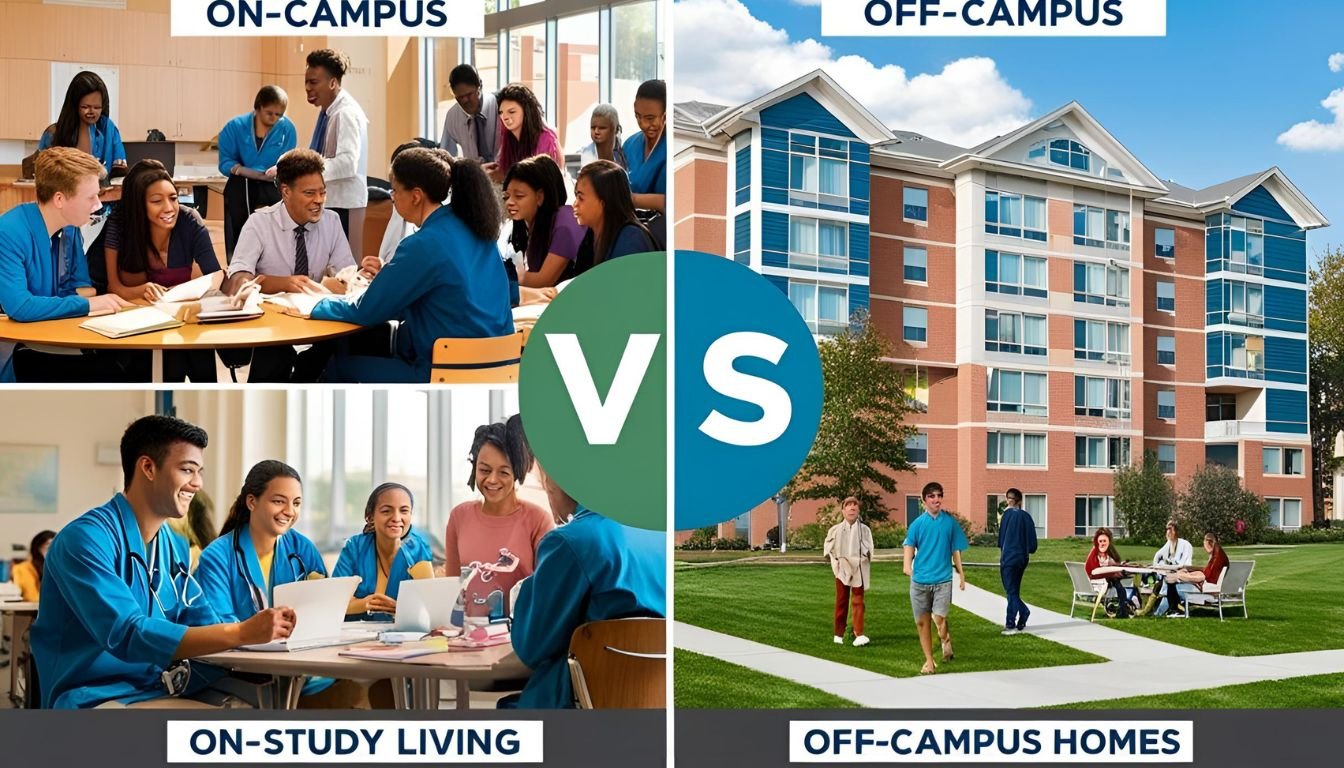Choosing where to live while studying medicine is a big decision. For students pursuing their education in Bangladeshi medical colleges, this choice can shape their entire experience. But how do you decide between on-campus and off-campus living?
Cost, safety, and proximity to academic resources are key factors. On-campus living often ranges from $1,500 to $2,000 per year, offering convenience and a sense of community. Off-campus alternatives might provide more independence but come with their own challenges.
For Indian students, cultural familiarity and the SAARC quota make Bangladeshi institutions an attractive option. Over 20 NMC-approved universities offer housing choices, ensuring students have modern amenities and a supportive environment.
Whether you prioritize affordability or flexibility, understanding these options can help you make the right choice. Let’s explore the pros and cons of each to guide your decision.
Introduction to MBBS Bangladesh Housing Options
Selecting the right place to stay can significantly impact your academic journey. For students pursuing medical education, the choice of accommodation is more than just a place to live. It’s a space that supports focus, fosters community, and enhances overall well-being.
Medical colleges in Bangladesh offer a 6-year program, including a 1-year internship at affiliated hospitals. This rigorous curriculum demands a supportive living environment. Recognized by NMC and WHO, these institutions provide a strong foundation for aspiring doctors.
Indian students benefit from reserved seats and the SAARC quota, which reduces tuition fees. This makes Bangladeshi universities an attractive option for those seeking quality education at an affordable cost. With 25% of seats reserved, securing admission becomes more accessible.
Timing is crucial when deciding on accommodation. Application cycles typically begin in February, aligning with the academic calendar. Planning ahead ensures you find a space that meets your needs and budget.
| Feature | Bangladesh Medical Education | Global Average |
|---|---|---|
| Program Duration | 6 years (including internship) | 5-6 years |
| FMGE Pass Rate | 37% | 20-25% |
| Admission Process | Direct, no donations | Varies by country |
Hostel facilities in these colleges often include basic amenities and separate accommodations for male and female students. Many also offer Indian food options, making it easier for international students to adapt. The medium of instruction is English, further enhancing comfort and accessibility.
Understanding these factors can help you make an informed decision about where to live. Whether you prioritize proximity to campus or cultural familiarity, your choice will shape your experience throughout your medical education.
Understanding On-Campus Housing for MBBS Students
Living on-campus can be a game-changer for medical students. It offers a supportive environment that fosters academic success and personal growth. With modern amenities and a strong sense of community, on-campus accommodations are designed to meet the needs of busy students.
Types of On-Campus Accommodations
Medical colleges provide a variety of room options to suit different preferences and budgets. Students can choose between single or double occupancy rooms, with or without air conditioning. For example, Bangladesh Medical College offers AC rooms equipped with WiFi and TV at $1,500 per year.
Other institutions, like Dhaka National Medical College, provide gender-separated hostel rooms to ensure comfort and privacy. With 320 rooms available, students have plenty of options to find a space that feels like home.
Availability and Application Process
Applying for on-campus housing is straightforward. Most universities centralize the process through their online portals during the admission process. Deadlines are strict, with Fall intake housing requests typically due by May 2024.
Nearly 94% of colleges include hostel fees in their tuition packages, making it easier for students to budget. This streamlined approach ensures that students can secure their accommodations early and focus on their studies.
| Feature | On-Campus Accommodations |
|---|---|
| Room Types | Single/Double, AC/Non-AC |
| Amenities | 24/7 Security, Indian Mess Food, Gyms, Study Lounges |
| Application Deadline | May 2024 for Fall Intake |
On-campus living also offers significant advantages, such as proximity to lecture halls and hospitals. This saves time and energy, allowing students to focus on their rigorous academic schedules. With services like 24/7 security and Indian mess food, students can enjoy a safe and comfortable environment.
Exploring Off-Campus Housing Alternatives
Finding the right place to live off-campus can offer flexibility and independence. For students, this choice often means balancing cost, convenience, and comfort. Whether you prefer private apartments, shared flats, or homestays, there are plenty of options to explore.
Private Apartments and Shared Flats
Private apartments and shared flats are popular among students. Near Dhaka Medical College, shared flats cost between $50 and $100 per month. This is a budget-friendly option for those looking to split expenses.
In cities like Rajshahi and Sylhet, rental costs vary. Dhaka tends to be more expensive, while smaller cities offer affordable alternatives. Popular areas like Bashundhara R/A and Uttara are ideal for students and families alike.
When selecting private accommodations, safety is a top priority. Always research the neighborhood and check for secure entry systems. Platforms like Bproperty and Lamudi Bangladesh can help you find verified listings.
Homestays and Hostels Outside Campus
Homestays provide a unique cultural experience. In Chittagong, they cost $80 to $120 per month, including meals. This option is especially beneficial for Indian vegetarians, as many hosts cater to dietary preferences.
Hostels outside campus are another affordable choice. They often include basic amenities and a communal living environment. This setup fosters connections with other students and locals.
Before signing a lease, ensure you have a No Objection Certificate (NOC) as part of your visa requirements. This document is essential for off-campus living and ensures compliance with local regulations.
- Compare rental costs in Dhaka, Rajshahi, and Sylhet.
- Prioritize safety when selecting private accommodations.
- Use platforms like Bproperty and Lamudi Bangladesh for verified listings.
- Obtain a No Objection Certificate for off-campus leases.
- Enjoy cultural benefits through homestays, especially for Indian vegetarians.
Pros and Cons of On-Campus Housing
Deciding between on-campus and off-campus living is a critical step for students. It’s a choice that can influence their daily routines, academic performance, and overall well-being. On-campus accommodations offer a structured environment, but they also come with certain limitations. Let’s explore the advantages and drawbacks to help you make an informed decision.
Advantages of Living On-Campus
Living on-campus provides students with immediate access to essential resources. Proximity to libraries, study groups, and teaching hospitals saves time and energy. Institutions like Khwaja Yunus Ali Medical College offer 24/7 security, ensuring a safe environment for students.
Structured meal plans are another benefit, especially for those with specific dietary preferences. Many colleges cater to Indian students by offering familiar food options. Free shuttle services to affiliated hospitals further enhance convenience, making it easier to balance studies and internships.
Drawbacks of On-Campus Living
While on-campus living has its perks, it also comes with challenges. Shared dormitories often mean limited personal space, which can be uncomfortable for some students. Mandatory curfews, enforced in 68% of hostels, may restrict flexibility and cultural integration.
Noise during exam periods is another common issue reported by students. Additionally, restricted guest policies can make it difficult to host friends or family, limiting social interactions. These factors are worth considering when evaluating your options.
- Pro: Immediate access to libraries and study groups.
- Pro: Structured meal plans catering to Indian dietary preferences.
- Con: Limited personal space in shared dormitories.
- Con: Restricted guest policies affecting social interactions.
- Con: Noise during exam periods as reported by students.
Pros and Cons of Off-Campus Housing
Exploring off-campus living opens doors to independence and flexibility. For students, this choice often means balancing freedom with responsibility. Whether you’re looking for a private apartment or a shared flat, understanding the benefits and challenges can help you make an informed decision.
Benefits of Choosing Off-Campus
Off-campus accommodations offer significant advantages. Shared apartments can save students up to 30% in costs compared to on-campus hostels. This makes it a budget-friendly option for those managing tight finances.
Another benefit is the freedom to choose your meals. Many students appreciate the ability to cook vegetarian or Indian dishes, ensuring dietary preferences are met. Additionally, living off-campus provides exposure to local culture, enriching the overall experience.
Challenges of Off-Campus Living
Despite the perks, off-campus living comes with its own set of challenges. Managing utility bills, such as electricity and water, can be overwhelming for some students. Language barriers with Bengali-speaking landlords may also pose difficulties during lease negotiations.
Safety is another concern. Conducting safety audits in neighborhoods near universities is essential. Registered lease agreements are also required for visa compliance, adding another layer to the process.
| Feature | Off-Campus Housing |
|---|---|
| Cost Savings | Up to 30% with shared apartments |
| Commute Time | Average 45 minutes to universities |
| Legal Requirements | Registered lease agreements |
Off-campus living can be a rewarding experience if planned carefully. By weighing the pros and cons, students can find a setup that supports their academic and personal goals.
Cost Comparison: On-Campus vs. Off-Campus
Budgeting for living expenses plays a key role in academic planning. For students, understanding the costs of on-campus and off-campus living is crucial. Let’s break down the expenses to help you make an informed decision.
On-campus accommodations typically range from $1,800 to $2,200 per year. This includes meals, utilities, and access to campus facilities. Off-campus living, on the other hand, averages $1,200 to $1,800 annually, but utilities are often excluded. Hidden costs like $150 security deposits for private apartments can add up.
Here’s a 5-year cost projection for both options:
| Expense | On-Campus | Off-Campus |
|---|---|---|
| Accommodation | $9,000-$11,000 | $6,000-$9,000 |
| Utilities | Included | $1,200-$3,000 |
| Transportation | Minimal | $500-$1,000 |
Living expenses vary by location. In Dhaka, costs are higher compared to Chittagong. For example, off-campus rent in Dhaka can be 20% more expensive. Students should also consider one-time costs like purchasing a mattress or utensils when moving off-campus.
Refund policies differ as well. Hostel deposits are often fully refundable, while rental agreements may deduct fees. On-campus residents save on transportation, as they live closer to academic buildings and hospitals.
By comparing these factors, students can choose the option that best fits their budget and lifestyle. Proper financial planning ensures a smoother academic journey.
Safety and Security Considerations
Safety is a top priority for students pursuing their education abroad. Whether living on-campus or off-campus, ensuring a secure environment is essential for academic success. Medical colleges and universities in the region take significant steps to protect their students.
On-campus hostels are equipped with advanced security measures. Nearly 97% of these accommodations have CCTV surveillance, ensuring round-the-clock monitoring. Emergency response times are also impressive, with an average of 8 minutes in Dhaka and slightly longer in rural areas.
For off-campus living, students should evaluate gated communities versus open-market rentals. Gated communities often provide additional security features like guarded entry points and private security services. Open-market rentals may require extra precautions, such as installing personal safety devices.
Universities have specific security protocols for female students. These include dedicated helplines, secure transportation options, and female-only accommodations. Apps like Pathao offer verified transport services, adding an extra layer of safety for daily commutes.
Indian students should register with their embassy upon arrival. The Indian Embassy in Dhaka can be reached at +880 96 6677 7888 for emergencies. Additionally, registering with local police stations is a crucial step for compliance and safety.
Here’s a quick overview of safety measures:
- 97% of on-campus hostels have CCTV surveillance.
- Emergency response times: 8 minutes in Dhaka, 15+ minutes in rural areas.
- Use apps like Pathao for verified transport services.
- Register with local police stations and your embassy.
Incident statistics from the Bangladesh Medical College area show a low crime rate, thanks to these robust security measures. By prioritizing safety, students can focus on their studies and enjoy a worry-free academic journey.
Cultural and Social Aspects of Housing Choices
The cultural and social environment of your living space can deeply influence your academic and personal growth. For Indian students, adapting to a new country while pursuing their studies is easier when surrounded by familiar traditions and supportive communities.
Many universities in the region host monthly cultural events through Indian Student Associations. These gatherings celebrate festivals like Durga Puja, fostering a sense of belonging. Living close to campus ensures you don’t miss out on these enriching experiences.
Roommate selection plays a key role in cultural adaptation. Sharing space with someone from a similar background can ease the transition. On the other hand, living with local students offers a chance to learn about Bengali culture firsthand.
Social opportunities vary between university dorms and city apartments. Dorms often have structured activities, while apartments provide more freedom to explore the local community. Both options have their unique advantages.
Intercollegiate events between Bangladeshi and Indian students further enhance cultural exchange. These events create lasting friendships and broaden perspectives. Alumni networks also play a vital role, offering guidance to new residents.
Orientation programs often include Bengali language basics, helping students navigate daily life. This small effort can significantly improve interactions with locals and enrich your overall experience.
- Monthly cultural events foster a sense of community.
- Roommate choice impacts cultural adaptation.
- Dorms and apartments offer different social opportunities.
- Intercollegiate events build lasting friendships.
- Alumni networks provide valuable support.
Tips for Choosing the Right Housing Option
Making the right choice for your living arrangements can shape your entire academic experience. Whether you’re considering on-campus or off-campus options, it’s essential to evaluate your needs and priorities. Let’s explore the factors to consider and the questions to ask when making this decision.
Factors to Evaluate Before Deciding
Start by assessing your budget, proximity to academic resources, and safety. Proximity to hospitals for clinical rotations is a key consideration. Ensure the location supports your daily routine and minimizes commute time.
Check the availability of essential services like water supply, electricity, and internet. Verify the safety of electrical wiring and obtain a Bangladesh Fire Service clearance if required. These steps ensure a secure and comfortable living environment.
Don’t forget to review the legal aspects of your lease. Ensure you have all required documents, including a valid visa and university admission letter. A registered lease agreement is also necessary for visa compliance.
Questions to Ask When Touring Housing
When visiting potential accommodations, ask the landlord or hostel warden these essential questions:
- What is the total cost, including utilities and deposits?
- Are there any restrictions on guests or curfews?
- How reliable is the mobile network coverage in the area?
- What safety measures are in place, such as CCTV or secure entry systems?
- Can the lease terms be negotiated, especially for international students?
Finally, consider the cultural and social aspects of your living space. A supportive environment can enhance your academic journey and personal growth. By carefully evaluating these factors, you can find the perfect place to call home during your studies.
Student Experiences: Real-Life Stories
Hearing from students who’ve lived through the experience can provide valuable insights. Their stories highlight the challenges and rewards of different living arrangements during medical studies. Let’s explore some real-life experiences to help you make an informed decision.
Rohan, a student from Kolkata, shared how living in a shared flat near Dhaka Medical College helped him improve his Bengali. “The daily interactions with locals made me more confident in speaking the language,” he said. On the other hand, Priya from Chennai found hostel life convenient despite limited food variety. “Saving three hours daily on commuting gave me more time to focus on my studies,” she explained.
Budgeting strategies are a common concern for students. Many shared tips like splitting utility costs with roommates or cooking meals at home to save money. Nightlife experiences also vary. While on-campus students enjoy structured events, off-campus residents often explore local cafes and cultural spots.
Initial settlement phases can be challenging. Adapting to a new environment, managing household chores, and navigating local customs are common hurdles. Peer recommendations often highlight areas like Bashundhara R/A and Uttara as ideal for students due to their safety and amenities.
Post-graduation transitions are another aspect to consider. Some students shared how their living arrangements prepared them for independent life. For example, managing off-campus leases taught them valuable skills in budgeting and negotiation.
| Aspect | On-Campus | Off-Campus |
|---|---|---|
| Language Learning | Limited interaction | Daily local exposure |
| Commute Time | Minimal | Up to 3 hours daily |
| Budgeting | Fixed costs | Variable expenses |
These stories and insights can help you weigh the pros and cons of each option. By learning from others’ experiences, you can find a living arrangement that supports your academic and personal goals.
Resources for Finding Housing in Bangladesh
Navigating housing options requires reliable resources and careful planning. For students, knowing where to look can make the process smoother and less stressful. Let’s explore the tools and platforms available to help you find the right place to stay.
University housing portals are a great starting point. Many institutions, like Dhaka National Medical College, offer dedicated portals for hostel applications. These platforms provide detailed information about room types, amenities, and application deadlines. Always check for updates during the admission process to secure your spot.
Verified brokers can also assist in finding off-campus accommodations. Reputable agencies like Al-Hera Estate and Green City Properties specialize in student rentals. They offer listings that meet safety and budget requirements, ensuring a hassle-free experience.
Social media groups, such as “Indian Students in Bangladesh – Housing,” are another valuable resource. These communities share verified listings, tips, and firsthand experiences. Engaging with peers can help you avoid scams and find seasonal discounts, especially during pre-monsoon vacancies.
Here are some tips to ensure a smooth housing search:
- Review rental agreements carefully to avoid hidden fees.
- Look for red flags like unverified listings or pressure to pay upfront.
- Keep emergency accommodation contacts handy during transitions.
By leveraging these resources, you can find a place that suits your needs and supports your academic journey. Proper planning ensures a comfortable and secure living environment throughout your studies.
Conclusion
Your living arrangement during medical studies plays a vital role in shaping your academic and personal growth. We’ve explored the cost-benefit analysis of on-campus and off-campus options, helping you align your choice with long-term career goals. Safety, cost, and convenience remain the key factors to prioritize in your decision-making process.
For students, early applications are crucial to secure premium accommodations. Starting your search well in advance ensures you find a space that meets your needs and budget. Whether you choose the structured environment of on-campus living or the independence of off-campus setups, planning ahead is essential.
As you move forward, leverage resources like university portals and verified brokers to streamline your search. By focusing on safety, affordability, and proximity to academic resources, you can create a supportive environment for your medical education journey. Take the next step confidently, knowing your choice will enhance your experience and success.





